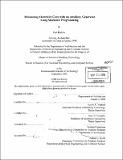| dc.contributor.advisor | Leslie K. Norford and John N. Tsitsiklis. | en_US |
| dc.contributor.author | Rafiuly, Paul, 1976- | en_US |
| dc.contributor.other | Massachusetts Institute of Technology. Dept. of Electrical Engineering and Computer Science. | en_US |
| dc.date.accessioned | 2012-02-29T17:26:32Z | |
| dc.date.available | 2012-02-29T17:26:32Z | |
| dc.date.copyright | 2000 | en_US |
| dc.date.issued | 2000 | en_US |
| dc.identifier.uri | http://hdl.handle.net/1721.1/69428 | |
| dc.description | Thesis (S.M.)--Massachusetts Institute of Technology, Dept. of Architecture; and, (S.M.)--Massachusetts Institute of Technology, Dept. of Electrical Engineering and Computer Science, 2000. | en_US |
| dc.description | Includes bibliographical references (p. 95-97). | en_US |
| dc.description.abstract | This thesis addresses the problem of minimizing a facility's electricity costs by generating optimal responses using an auxiliary generator as the parameter of the control systems. The-goal of the thesis is to find an optimization method that can cope with the uncertainty in the building load while also handles the complex electricity price structures. The building load is the random factor of the stochastic problem and is composed of the weather load and the occupancy load. Several optimization techniques such as Dynamic Programming and Linear Programming (deterministic optimization) are looked at. Stochastic Programming using Nested Bender's Decomposition method is chosen and studied to solve the optimization problem. Stochastic Programming, which is a hybrid of Dynamic Programming and Linear Programming, is used because it can cope with the complex electricity price structures and the uncertainty of the building load while avoiding an explosion in the number of states. However, the method is not suitable for our problem, which is a Mixed Integer Programming problem. Moreover, the random sampling adds some limitations on the method. In addition, the ~high memory requirement and the extensive computational time prohibit the method from being used for a long planning period. Hence, a new control system, which is the combination of Stochastic Programming and Linear Programming, is proposed. The key of this proposed method is the reduction of the problem into a two-stage stochastic problem. | en_US |
| dc.description.statementofresponsibility | by Paul Rafiuly. | en_US |
| dc.format.extent | 97 p. | en_US |
| dc.language.iso | eng | en_US |
| dc.publisher | Massachusetts Institute of Technology | en_US |
| dc.rights | M.I.T. theses are protected by
copyright. They may be viewed from this source for any purpose, but
reproduction or distribution in any format is prohibited without written
permission. See provided URL for inquiries about permission. | en_US |
| dc.rights.uri | http://dspace.mit.edu/handle/1721.1/7582 | en_US |
| dc.subject | Architecture. | en_US |
| dc.subject | Electrical Engineering and Computer Science. | en_US |
| dc.title | Minimizing electricity costs with an auxiliary generator using stochastic programming | en_US |
| dc.type | Thesis | en_US |
| dc.description.degree | S.M. | en_US |
| dc.contributor.department | Massachusetts Institute of Technology. Department of Architecture | |
| dc.contributor.department | Massachusetts Institute of Technology. Department of Electrical Engineering and Computer Science | |
| dc.identifier.oclc | 48455440 | en_US |
